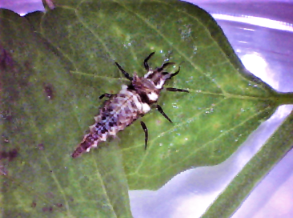
Mimosa webworm early webbing of honeylocust leaflets at outer branches. (Photo Credit: Steven K. Rettke, Rutgers Coop. Ext.)
Mimosa Webworm (Homadaula anisocentra) = (880-1200 GDD = 1st generation egg hatch): The overwintering pupal cocoons of this non-native caterpillar emerged as adults last June & eggs have been laid on leaflets or small twigs of honeylocust (Gleditisia tricanthos ) trees in NJ. This caterpillar also feeds on mimosa trees, but since honeylocust plantings in the urban environment are more common, we usually encountered them on these trees. Within many areas of the state, the early, initial 1st generation webbings by 1st instar caterpillars are now becoming noticeable at the outer edges of the leaf canopy.
Larval Stages: The early instar mimosa webworm caterpillar larvae initially feed by etching the undersides of leaflets. The 1st of the 5 or 6 instar larvae are only 2mm (~1/12 inch) in size. The mature caterpillar reaches 16mm (< 3/4 inch) in size. The late instars have a brownish body with five white stripes that run along its length. They use webbing to bring the leaflets together to create protective feeding areas. As the larvae grow & develop, the webbing becomes progressively larger & denser. The later instars will skeletonize the leaves & then eventually consume entire leaflets. The mature 1st generation larvae will pupate within the webbing where they will emerge as adults.
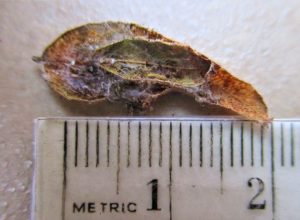
The 1st instar mimosa webworm is only about 2mm in size. They use webbing to clump leaflets together, creating protective feeding areas. (Photo Credit: Steven K. Rettke, Rutgers Coop. Ext.)
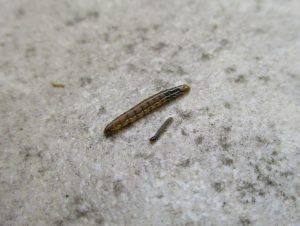
The mature instar mimosa webworm caterpillar (possibly 6th instar) is about 16mm (<3/4″). The smaller caterpillar at right is probably a 3rd instar? Out of focus 1st instar is at far left. (Photo Credit: Steven K. Rettke, Rutgers Coop. Ext.)
First Generation: In NJ, the 1st generation does most of its feeding during July. Often, this generation causes less obvious symptoms to the honeylocust. However, controlling the 1st generation will help prevent the build-up from the 2nd generation. Feeding symptoms become significantly more pronounced during the 2nd generation in August/September. This typically occurs because when the 1st generation adults emerge they will lay eggs within the previous webbing & the 2nd generation will expand the damage.
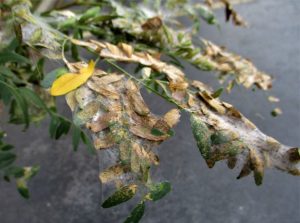
As the caterpillars continue to develop, the leaf webbing becomes more extensive. (Photo Credit: Steven K. Rettke, Rutgers Coop. Ext.)

The early instars feed by “etching” the outer leaflet epidermis tissues. (Photo Credit: Steven K. Rettke, Rutgers Coop. Ext.)
Second Generation: The 2nd generation eggs will hatch & feed during August & into September (1800-2100 GDD = egg hatch). The 2nd generation larvae will expand the initial feeding area & create more observable webs & leaf browning symptoms. With more extreme infestations, the webbing of leaves can occur throughout the entire crown of a tree. The tree may appear as if it was scorched by fire. This generation can be a further nuisance when mature larvae hang from threads as they silk down from the tree canopy in late summer.
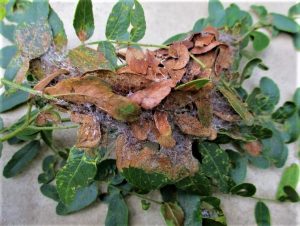
As the mimosa webworm webbing becomes more dense, then insecticide controls will become more difficult. (Photo Credit: Steven K. Rettke, Rutgers Coop. Ext.)
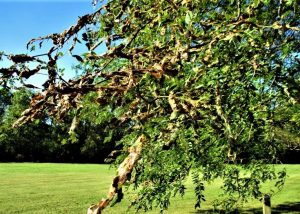
As mimosa webworm infestations become extreme, then the tree canopy will have a bown, burnt appearance as if scorched by fire. (Photo Credit: Steven K. Rettke, Rutgers Coop. Ext.)
Winter Survival: The state of NJ is near the northern limit for climate adaptability of the mimosa webworm. Winter survival within NY state & into upper New England become much reduced. Although mature larvae will attempt to pupate & overwinter within protected areas such as bark flaps & cracks of the trunk, cold winter temperatures can reduce survival. Even within our region, survival will be enhanced within urban settings. For example, trees located along streets & other paved areas will generally experience the highest caterpillar populations. Heat radiated from the winter sun by paved surfaces can keep temperatures higher around trees.
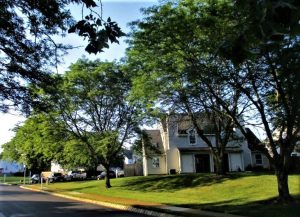
Mimosa webworm have better winter survival in urban areas such as along paved streets or near buildings. (Photo credit: Steven K. Rettke, Rutgers Coop. Ext.)
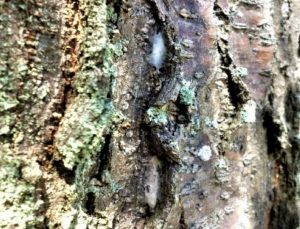
Mimosa webworm overwintering pupal cocoons attempt protection within bark flaps & crevices of honeylocust tree trunks. (Photo Credit: Steven K. Rettke, Rutgers Coop. Ext.)
Pupation Stage: The bright white cocoons have the appearance of puffed rice & will typically occur in masses grouped together. Most cocoons are observed on the main tree trunk or the major lower scaffold branches. If the populations are mild, then finding these cocoons will require close inspections since they can be hidden deep within bark flaps & crevices.
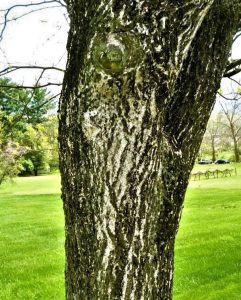
The overwintering pupal cocoons are not difficult to find with extreme populations. (Photo Credit: Steven K. Rettke, Rutgers Coop. Ext.)
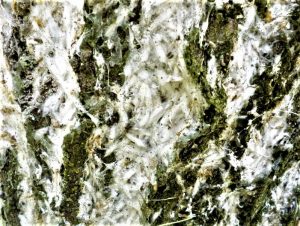
A close-up of the unusually extreme population of overwintering mimosa webworm pupal cocoons. The cocoons have the appearance of puffed-up white rice as they are massed together in groups. (Photo Credit: Steven K. Rettke, Rutgers Coop. Ext.)
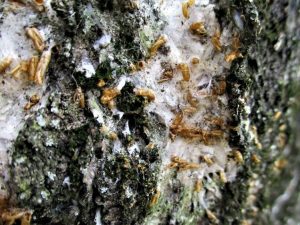
The 1/4-inch brown pupal skins are numerous as mimosa webworm adults emerge. (Photo Credit: Steven K. Rettke, Rutgers Coop. Ext.)
Adults & Eggs: The silver-gray adult moths have black speckles & are only about 3/8- inch long. In NJ they emerge from cocoons primarily during June & then again primarily in early August. The 1/4-inch brown pupal skins are an obvious color contrast against the white cocoons. Adult observance is rare since they are mostly nocturnal. Adults may live for a few weeks & females will lay exceedingly small, oval shaped, pearly-white eggs on leaves or small stems. During late July & August, the 2nd generation eggs will often be laid on 1st generation webbing. This causes the 2nd generation to create the more obvious symptoms.
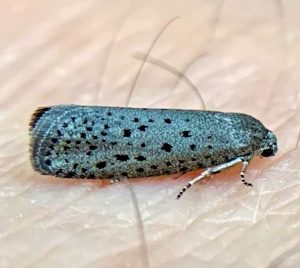
The adult mimosa webworm moth has a steel gray appearance with black speckles. (Photo Credit: Dan McCord, Indiana State Coop. Ext.)
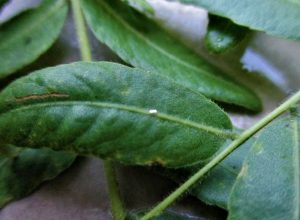
Females lay exceptionally small, oval, pearly-white eggs on leaves or small stems. 2nd generation eggs are often laid on previous webbings made by the 1st generation. (Photo Credit: Steven K. Rettke, Rutgers Coop. Ext.)
Resistance: Thornless honeylocust varieties are most favored by the mimosa webworm. The variety Sunburst is highly susceptible. Although damage will usually be less, other varieties including Shademaster, Imperial, Moraine, & Skyline are still prone to infestations.
Insecticides & Controls: Apply insecticide control sprays against the mimosa webworms during late June or early July before the webbing becomes dense. The successful suppression of the 1st generation can greatly reduce the emergence of the 2nd generation & prevent this pest from becoming a problem on honeylocust trees during the year. Bacillus thuringiensis (Bt) is a bacterial microbial formulation that is applied to foliage. The bacterial protein crystals act as a stomach poison when consumed by caterpillars. The Bt crystals work best against young instar caterpillars & thus need to be applied early for best efficacy. Other reduced-risk insecticides include spinosad (Conserve) & chlorantraniliprole (Coragen) & are labeled for use against caterpillars. When applying any insecticide spray, be certain to soak the webbing area thoroughly. If some of the more broad-spectrum insecticides are used (e.g., pyrethroids, carbaryl), then be on the look-out for secondary pest resurgence by spider mites. Also, the reduced-risk materials will help conserve the many predators like green lacewings, assassin bugs & parasitoid wasps which can often keep populations suppressed.
